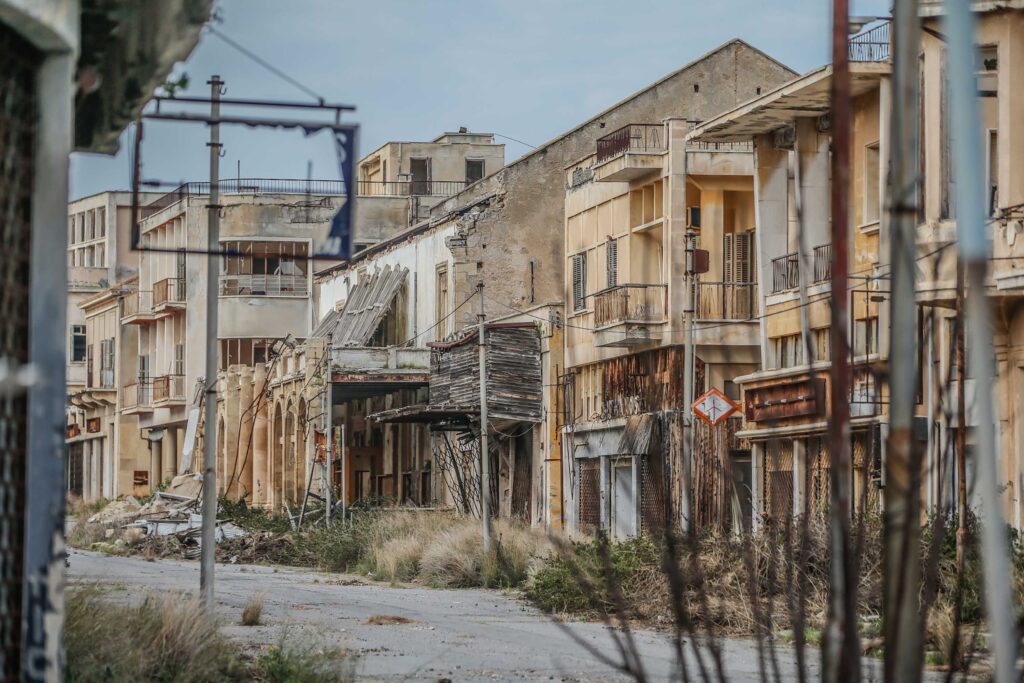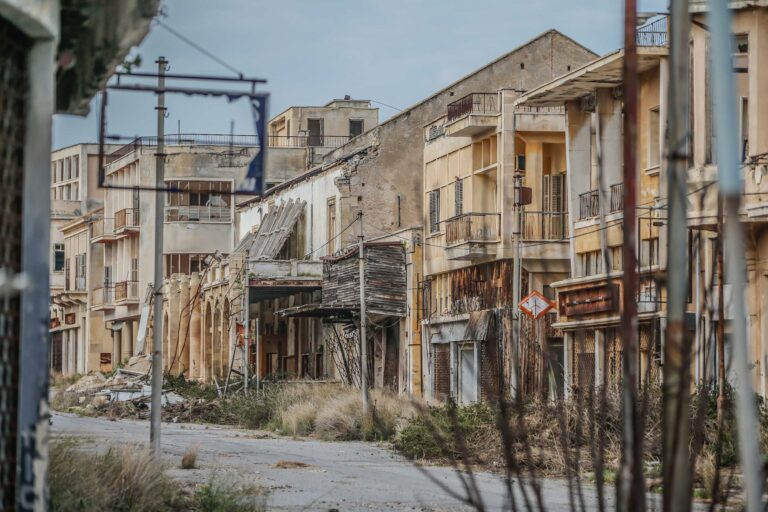Explore Varosha, the abandoned ghost town of Famagusta, North Cyprus. Discover its eerie silence, tragic history, and uncertain future.

Once a luxury playground of the Mediterranean, now a haunting monument of conflict. northcyprusinvesting.com
Introduction: Where Time Stopped in 1974
Few places in the world evoke such a strong mix of curiosity, sorrow, and mystery as Varosha, the sealed-off district of Famagusta, in Northern Cyprus. Once a booming resort town—packed with glamorous hotels, buzzing cafés, and golden beaches—it is now eerily quiet. Palm trees grow wild, buildings crumble, and nature creeps through abandoned cars and shops, untouched for decades.
This ghost town is more than just an abandoned urban area; it’s a symbol of the island’s troubled past. Today, as parts of Varosha slowly reopen to visitors after nearly 50 years, it offers a rare and emotional glimpse into history—one that few other places can match. Investra.io
1. The Glory Days: Varosha Before the Fall
In the 1960s and early 1970s, Varosha was the crown jewel of Cyprus tourism. Its coastline was lined with luxury hotels such as the Argo Hotel, where stars like Elizabeth Taylor, Richard Burton, and Brigitte Bardot once stayed. International travelers flooded the town, drawn by its modern architecture, vibrant nightlife, and postcard-perfect beaches.
Famagusta itself was a thriving cultural and economic hub. With its bustling harbor, diverse communities, and rich history dating back to medieval times, it was poised to become one of the top destinations in the Mediterranean.
But this glamorous life came to an abrupt halt. northcyprusinvesting.com, Investra.io
2. 1974: The Invasion and Sudden Abandonment
In July 1974, a military coup backed by Greece sought to unite Cyprus with Greece. This triggered a Turkish military intervention, leading to the island’s division. As Turkish forces approached Famagusta, the residents of Varosha fled in panic—expecting to return in a few days. They never did.
Turkish forces took control of the area and fenced it off. Entry was forbidden to civilians—including Turkish Cypriots. The once-bustling town became a ghost city overnight, guarded by soldiers and swallowed by time. Buildings decayed, plants overtook roads, and shop windows remained frozen with 1970s fashion.
For decades, Varosha stood still, locked away behind barbed wire and political deadlock. No reconstruction. No visitors. Just silence.
3. Life Behind the Fence: 1974–2020
For nearly 46 years, Varosha was a military zone under Turkish control. It became a powerful symbol of Cyprus’s unresolved conflict. International organizations, including the UN and EU, considered any resettlement of Varosha by anyone other than its original (mostly Greek Cypriot) residents a violation of UN resolutions.
Aerial photos and secret snapshots showed a place in slow decay: crumbling hotels, rusted cars, trees bursting through floors. The stories about this forbidden city only added to the mystery. What remained? Were homes still furnished? Was the beach still beautiful?
The answer was yes—but time had left its mark.
4. A Town Reawakens: Varosha’s Reopening in 2020
In October 2020, part of Varosha was unexpectedly reopened to the public by Turkish and Turkish Cypriot authorities. Visitors were now allowed to walk through some areas of the ghost town, especially along the beachfront and a few main roads.
Reactions were mixed. Greek Cypriots, many of whom still hold property deeds to homes in Varosha, saw it as a provocation. Others viewed it as an opportunity to reopen dialogue about the island’s future.
Today, Varosha is partially open as a “memory site”—a surreal mix of decaying buildings, military fences, and newly cleaned paths for tourists. Some streets have been cleared of overgrowth, signs have been installed, and even bike rentals are available. But the eerie atmosphere remains.
5. How to Visit Varosha Today – What to Expect
If you’re planning a trip to North Cyprus, visiting Varosha is now one of the most unique experiences on the island.
Where to enter:
Access is through the southern part of Famagusta, near Palm Beach. Entry is free, but identification (passport or ID) is required.
What you can see:
- Palm-lined roads and beachfronts
- The crumbling façade of the Argo Hotel
- Empty houses overtaken by nature
- Signs detailing Varosha’s history and restricted areas
- Military fences beyond which entry is strictly prohibited
Rules to know:
- Drones are not allowed
- You can take photos in the open areas, but not beyond fences
- Respect all marked paths and avoid sealed-off buildings for safety reasons
6. The Future of Varosha: Hope or More Conflict?
The future of Varosha is deeply tied to the Cyprus Problem—the decades-long division between the Greek Cypriot south and Turkish Cypriot north. While some see the partial opening as a step toward reconciliation, others fear it undermines peace efforts.
Talks about returning Varosha to its original inhabitants under UN administration have stalled multiple times. Property rights remain a legal and emotional battlefield. For now, Varosha stands as a space of contradiction: both hopeful and heartbreaking, open yet restricted, alive and abandoned.
Conclusion: A Living Ruin of the Mediterranean
Walking through Varosha is like stepping into a time capsule. It tells a story not only of war and displacement but of dreams halted in midair. For visitors, it’s an unforgettable experience—a place where tourism meets memory, and silence speaks volumes.
Whether you visit out of curiosity, historical interest, or respect for what was lost, Varosha leaves an impression few places can. In a world of fast-changing cities and vanishing heritage, it remains—poignantly, painfully—unchanged. northcyprusinvesting.com, Investra.io


